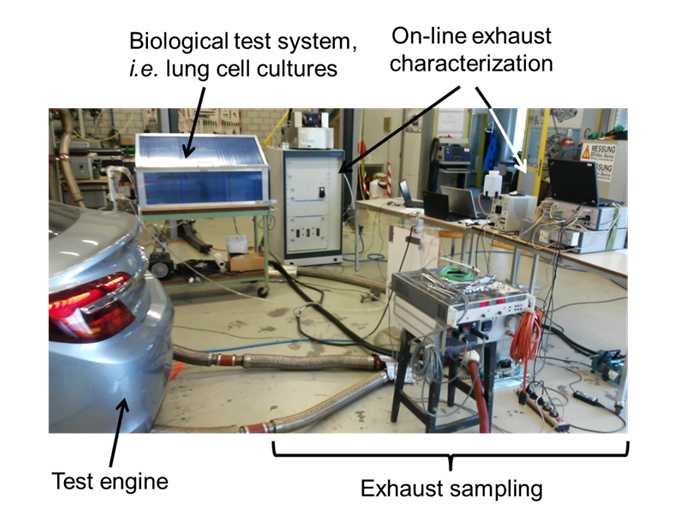Diesel Exhaust Emissions Treatment
Human Lung Cell Reactions After Diesel Exhaust Exposure
Automotive exhaust has been under investigation for many years. In 1921 already, Yandell Henderson and his colleagues observed toxicity in men and horses when exposed [1]; this was however only related to carbon monoxide. In the decades afterwards, the toxicity of other exhaust constituents such as the particulate fraction, nitrogen oxides, hydrocarbons, aldehydes, oxidants, and metals was recognized (for a review see [2]). Since then, the car industry has developed a variety of exhaust after-treatment systems to diminish the effects of, or reduce, certain exhaust components, while the use of alternative fuels has also been promoted.
There is an urgent need to develop fast and reliable exposure systems to test the exhaust output of different cars with new after-treatment technologies or different fuels. A novel exposure system was developed to evaluate possible adverse effects in lung cells in vitro of scooter or automotive exhaust in a realistic manner by directly subjecting the surface of a 3D human lung cell model to fresh exhaust fumes. The system has the advantage that the exhaust can be characterized on-line while at the same time making it possible to connect any possible adverse effect to its composition (Figure 1).
The method was established and optimized first for scooter exhaust [4], and then for diesel passenger cars. Different variables like (bio)fuels [5], diesel particle filters [6], fuel-borne catalysts [7], lube oils, and nitrous oxide were tested, showing that the system is reliable. The results of the diesel particle filter studies (relative to unfiltered exhaust) are shown in Table 1.
| (uncoated) diesel particle filter | Diesel particle filter plus fuel-borne catalyst | |
| Oxidative stress (GSH)* | Lower (six-fold) | Lower (six-fold) |
| Oxidative stress (gene expression analysis) | Equal (no oxidative stress on the gene level) | Equal or lower (gene-dependent) |
| Pro-inflammation (protein levels TNFa and IL-8) | Equal (no pro-inflammation) | Higher (1.6 times) |
| Pro-inflammation (gene expression analysis of TNFa and IL-8) | Lower (approx. two times lower, no pro-inflammation for this treatment) |
Lower (approx. two times lower, no pro-inflammation for this treatment)
|
Table 1: Results from the diesel particle filter studies. Summary relative to unfiltered (reference) exhaust. *Oxidative stress increased in every exhaust, but differences between were observed.

Figure 1: Exposure system. Freshly produced exhaust is directly applied to the human lung cell cultures within 30 seconds.
References
1. Henderson, Y., Physiological effects of automobile exhaust gas and standards of ventilation for brief exposures. 1921: The Journal.
2. Stupfel, M., Recent advances in investigations of toxicity of automotive exhaust. Environ Health Perspect, 1976. 17: p. 253-85.
3. IARC, Press release 213. 2012.
4. Muller, L., et al., New exposure system to evaluate the toxicity of (scooter) exhaust emissions in lung cells in vitro. Environ Sci Technol, 2010. 44(7): p. 2632-8.
5. Steiner, S., et al., Comparison of the toxicity of diesel exhaust produced by bio- and fossil diesel combustion in human lung cells in vitro. Atmospheric Environment, 2013. 81: p. 380-388.
6. Steiner, S., et al., Reduction in (pro-)inflammatory responses of lung cells exposed in vitro to diesel exhaust treated with a non-catalyzed diesel particle filter. Atmospheric Environment, 2013. 81: p. 117-124.
7. Steiner, S., et al., Effects of an iron-based fuel-borne catalyst and a diesel particle filter on exhaust toxicity in lung cells in vitro. Anal Bioanal Chem, 2014.
Author: Christoph Bisig (University of Fribourg)
For more information contact
